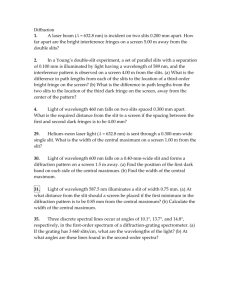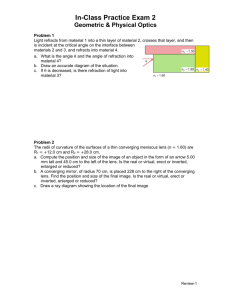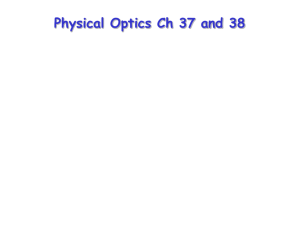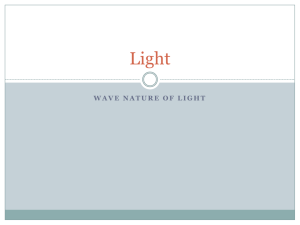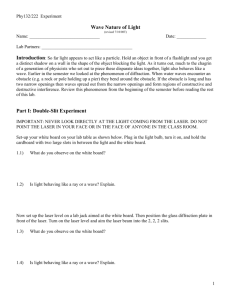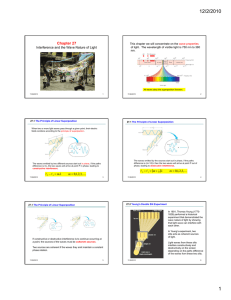Chapter 24 Interference and the Wave Nature of Light
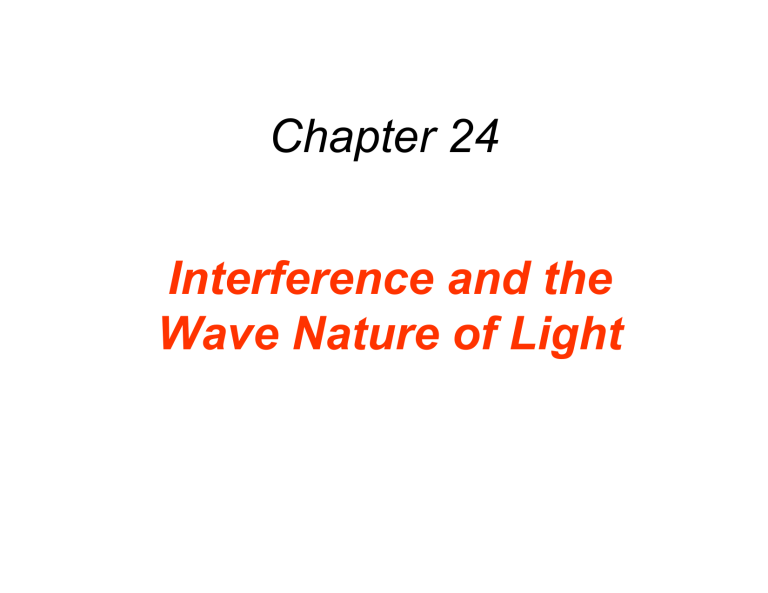
Chapter 24
Interference and the
Wave Nature of Light
The Dispersion of Light: Prisms and Rainbows
The net effect of a prism is to change the direction of a light ray.
Light rays corresponding to different colors bend by different amounts.
The Dispersion of Light: Prisms and Rainbows
The Dispersion of Light: Prisms and Rainbows
When sunlight emerges from a water droplet, the light is dispersed into its constituent colors.
The different colors seen in a rainbow originate from water droplets at different angles of elevation.
The Principle of Linear Superposition
When two or more light waves pass through a given point, their electric fields combine according to the principle of superposition.
The waves emitted by the sources start out in phase and arrive at point P in phase, leading to constructive interference.
2
−
1
= m
λ
m = 0 , 1 , 2 , 3 ,
…
The Principle of Linear Superposition
The waves emitted by the sources start out in phase and arrive at point P out of phase, leading to destructive interference.
2
−
1
=
( m + 1
2
)
λ
m = 0 , 1 , 2 , 3 ,
…
The Principle of Linear Superposition
If constructive or destructive interference is to continue ocurring at a point, the sources of the waves must be coherent sources .
Two sources are coherent if the waves they emit maintain a constant phase relation.
Young ’ s Double Slit Experiment
In Young ’ s experiment, two slits acts as coherent sources of light.
Light waves from these slits interfere constructively and destructively on the screen.
Young ’ s Double Slit Experiment
The waves coming from the slits interfere constructively or destructively, depending on the difference in distances between the slits and the screen.
Young ’ s Double Slit Experiment
Bright fringes of a double-slit
Dark fringes of a double-slit
Δ = d sin θ sin
θ
= m
λ
m d
= 0 , 1 , 2 , 3 ,
…
sin
θ
=
( m + 1
2
)
λ
m d
= 0 , 1 , 2 , 3 ,
…
Young ’ s Double Slit Experiment
Example: Young ’ s Double-Slit Experiment
Red light (664 nm) is used in Young ’ s experiment with slits separated by 0.000120 m. The screen is located a distance 2.75 m from the slits.
Find the distance on the screen between the central bright fringe and the third-order bright fringe.
Young ’ s Double Slit Experiment
θ
= sin − 1
⎛
⎜
⎝ m
λ
d
⎞
⎟
⎠
= sin − 1
⎛
⎜⎜
⎝
3
664
1.20
× 10
× 10
− 9
− 4 m m
⎞
⎟⎟
⎠
= 0 .
951 y = L tan
θ
= ( 2 .
75 m ) tan ( 0 .
951 )
= 0 .
0456 m
Young ’ s Double Slit Experiment
Conceptual Example: White Light and Young ’ s Experiment
The figure shows a photograph that illustrates the kind of interference fringes that can result when white light is used in Young ’ s experiment.
Why does Young ’ s experiment separate white light into its constituent colors? In any group of colored fringes, such as the two singled out, why is red farther out from the central fringe than green is? Why is the central fringe white?
Diffraction
Diffraction is the bending of waves around obstacles or the edges of an opening.
Huygens ’ principle
Every point on a wave front acts as a source of tiny wavelets that move forward with the same speed as the wave; the wave front at a latter instant is the surface that is tangent to the wavelets.
Diffraction
The extent of the diffraction increases as the ratio of the wavelength to the width of the opening increases.
Diffraction
Diffraction
This top view shows five sources of Huygens ’ wavelets.
Diffraction
These drawings show how destructive interference leads to the first dark fringe on either side of the central bright fringe.
Dark fringes for single-slit diffraction sin
θ
= m
λ
W m = 1, 2, 3......
Example for single-slit diffraction. Light passes through a slit an shines on a flat screen that is located L = 0.40 m away. The wavelength of the light in a vacuum is λ = 410 nm. The distance between the midpoint of the central bright fringe and the first dark fringe is y . Determine the width 2y of the central bright fringe when the width of the slit is (a) W = 5.0 x 10 -6 m and (b) W = 2.5 x 10 -6 m. first dark fringe
W
{
θ
θ
y midpoint of central bright fringe y first dark fringe
L
( )
θ
= sin − 1
$
"
#
λ
W
%
&
' = sin − 1
$
"
#
410 × 10 − 9
5.0
× 10 − 6
%
&
' = 4.7
o
2 y = 2 L tan
θ
= ( ) tan 4.7
o
= 0.066
m
( ) 2 y = 0.13
m à The width of the central bright fringe is greater for smaller W
Diffraction
Diffraction pattern formed by an opaque disk.

